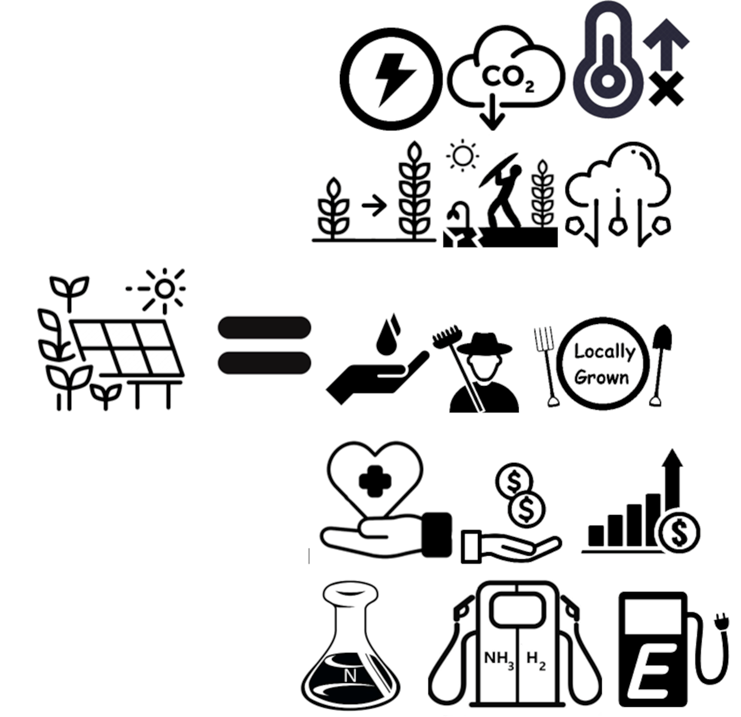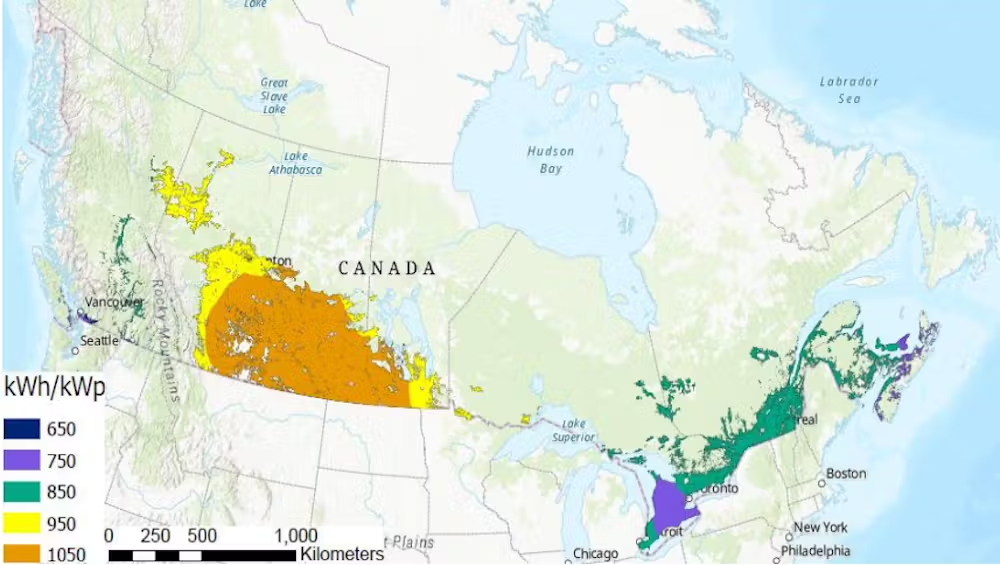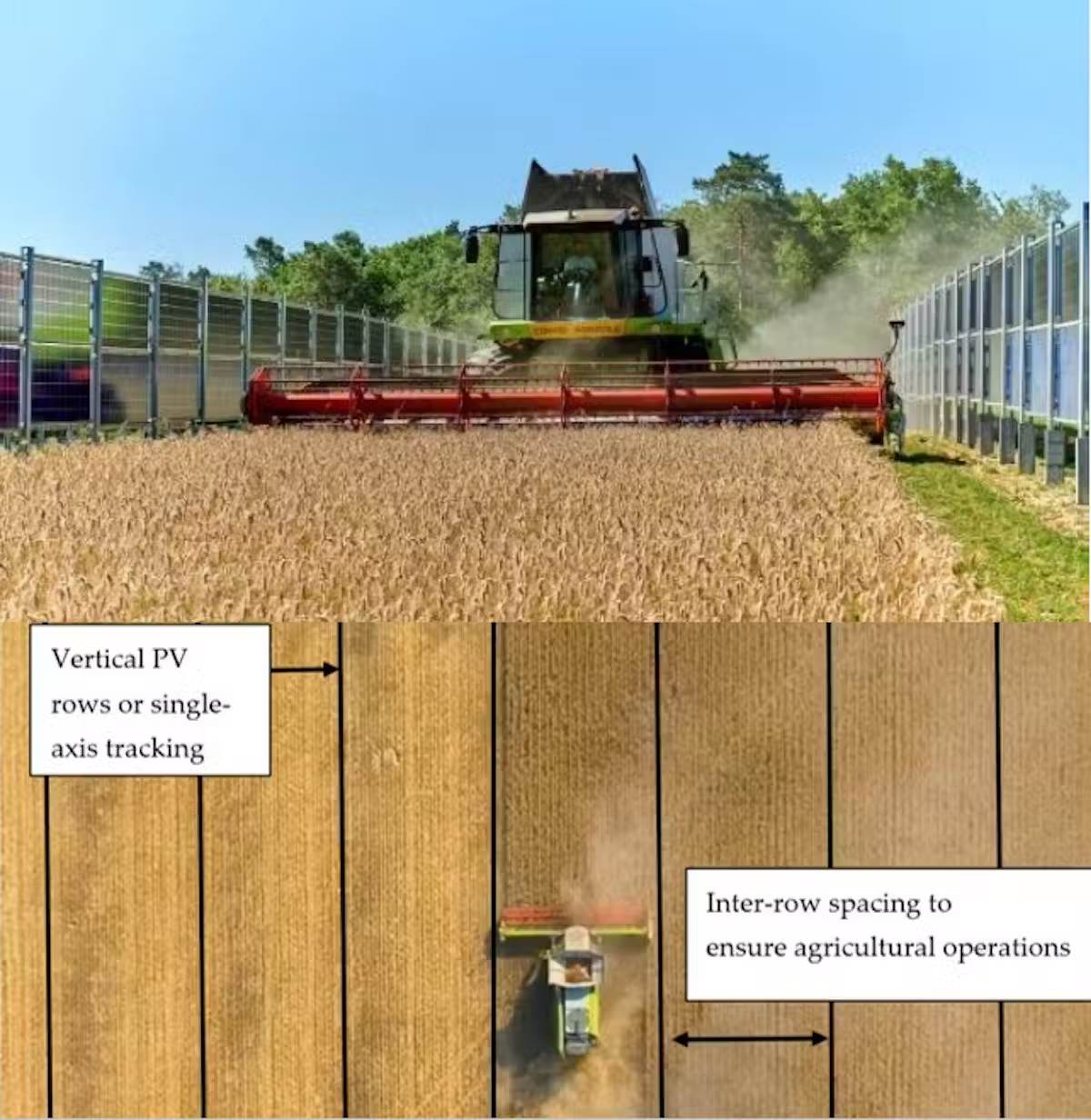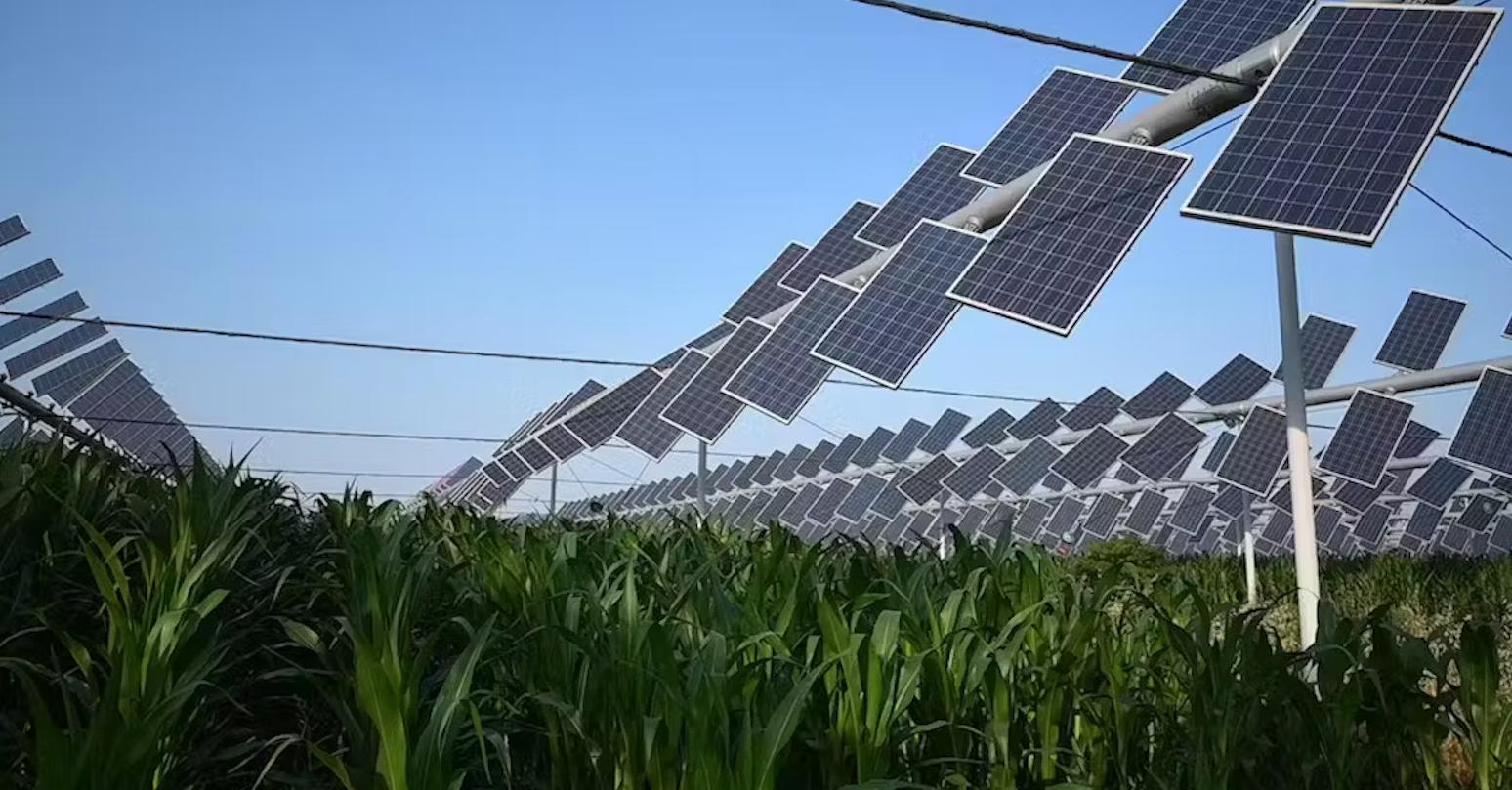If you have lived in a home with a trampoline in the backyard, you may have observed the unreasonably tall grass growing under it. This is because many crops, including these grasses, actually grow better when protected from the sun, to an extent.
And while the grass under your trampoline grows by itself, researchers like me in the field of solar photovoltaic technology — made up of solar cells that convert sunlight directly into electricity — have been working on shading large crop lands with solar panels — on purpose.
This practice of growing crops in the protected shadows of solar panels is called agrivoltaic farming. And it is happening right here in Canada.
Such agrivoltaic farming can help meet Canada’s food and energy needs and reduce its fossil fuel reliance and greenhouse gas emissions in the future.
When shade equals protection
Our recently published paper found that Canada has an enormous agrivoltaic potential as it is a global agricultural powerhouse — with Canadian-produced food export goals set at $75 billion by 2025.

Many crops grown here, including corn, lettuce, potatoes, tomatoes, wheat and pasture grass have already been proven to increase with agrivoltaics.
Studies from all over the world have shown crop yields increase when the crops are partially shaded with solar panels. These yield increases are possible because of the microclimate created underneath the solar panels that conserves water and protects plants from excess sun, wind, hail and soil erosion. This makes more food per acre and could help bring down food prices.
And as the costs of solar energy plummet, nations across the world are installing agrivoltaic systems and offsetting the burning of fossil fuels by profitably producing more renewable energy.
Solar farming is now trending globally
The agricultural industries in Europe, Asia and the United States have been aggressively expanding their agrivoltaic farms with wide public support.
In Europe, solar panels are put over different types of crops, including fruit trees. Meanwhile, in China, agrivoltaics is used to reverse desertification which is literally using solar panels to green former deserts.
In the U.S., social science studies have shown the photovoltaic industry, farmers and the general public are enthusiastically looking forward to the implementation of such projects.
Surveys of the rural U.S., from Michigan to Texas, show 81.8 % of respondents would be more likely to support solar development in their community if it integrated farming. Rural residents generally like the idea of maintaining agricultural jobs, increased revenue from the sale of energy and the fact that it could provide a continued source of income. They believe it can act as a buffer against inflation and bad growing seasons.
It’s time to expand Canadian solar farms
In Canada, agrivoltaics has primarily been applied to conventional solar farms and used by shepherds and their sheep. While the shepherds get paid to cut the grass on solar farms, the sheep use the grass and pastures under the solar panels for shade and grazing. Sheep-based agrivoltaics is found throughout Canada.
 A map showing the agrivoltaic potential in Canada
A map showing the agrivoltaic potential in Canada
The life cycle analysis of agrivoltaics, which assesses its impact from its conception to use, found that these solar-covered farms emit 69.3 % less greenhouse gases and demand 82.9 % less fossil energy compared to separate food farms and solar farms-based production.
This is great, but to remain competitive with other major agriculture producers, Canada needs to start large-scale agriculture in the shadow of solar panels. This will enable the production of numerous crops that have been known to increase yield when covered.
This would include vegetables like broccoli, celery, peppers, lettuce, spinach and tomatoes as well as field crops like potatoes, corn and wheat.
Seriously embracing agrivoltaics in Canada would completely drop fossil fuel use. Less than 1 % of Canadian land would be sufficient to support over 25% of the country’s electrical energy needs using this system.
This in turn can help the nation honor its commitment to reducing greenhouse gas emissions by increasing the non-emitting share of electricity generation to 90% by 2030.
Agrivoltaic solar farms outstrip electricity demand
The potential of agrivoltaic-based solar energy production in Canada far outstrips current electric demand. This solar energy can be used to electrify and decarbonize transportation and heating, expand economic opportunities by powering the burgeoning computing sector and export green electricity to the U.S. to help eliminate their dependence on fossil fuels as well.
Electricity produced by agrivoltaic farms can also be stored by charging electric vehicles as well as hydrogen production, thus benefiting transportation. Solar can already profitably meet Ontario households’ heating requirements by replacing natural gas furnaces with solar-powered heat pumps.
Lastly, any extra agrivoltaic electricity could be used to power computing facilities and cryptocurrency miners at profit and possibly be exported to the U.S. to help them clean up their much dirtier grid. This would help increase our trade surplus as well as the health and environmental benefits of decreasing the American pollution that wafts across the border.
When benefits massively outweigh the costs
Despite the numerous benefits of agrivoltaic farming, there are some barriers to its distribution in Canada. There are well-intentioned regulations that are holding these farms back.
In Ontario for example, you cannot install solar in the Greenbelt because of the law to protect farms. Similar issues arise in Alberta on Crown Land.
Worse yet, The Alberta government recently announced a much-maligned seven-month pause on renewable (including solar) energy development in the province. Alberta’s energy portfolio is changing rapidly. Low-cost solar energy is now growing so fast as to be a “gold rush” in Alberta.
In fact, much to Ontario’s shame, Alberta has taken on the leadership role in solar development in Canada, generating millions of solar dollars and creating thousands of solar jobs for Alberta’s energy workers.
Solar companies have grown so fast precisely because there is large profits to be had in offsetting costly fossil-fuel electricity. However, many in Alberta are worried that this new boom will lead to higher food costs, scarred landscapes and a repeat of costs from cleaning up after the oil and gas industry.
This particular land-use conflict between solar and agriculture has been a concern for solar researchers like myself for some time. However, our research in the United States has shown that agrivoltaics provide higher economic productivity, energy and food yields. So much so that the U.S. Department of Energy is now investing millions of dollars to ensure America’s dominance in the field.
One of the studies in the U.S., for example, observed pepper production shoot up by more than 200 % while other crops like wheat in Germany were more reserved with a few % increase — but they still produced more wheat.
Not surprisingly, agrivoltaics is slated to grow to a $9.3 billion market by 2031.
Last year, we held the first agrivoltaics conference anywhere in North America at the Ivey Business School. The trade group made up of farmers and solar companies called Agrivoltaics Canada has formed because agrivoltaic farming can help meet Canada’s food and energy needs all the while getting rid of our fossil fuel reliance and greenhouse gas emissions (and the associated emissions liabilities).
 Farming machinery operating between solar panels
Farming machinery operating between solar panels
Agrivoltaics will allow Alberta’s farmers to keep farming, make more money, drop energy costs, and help protect the environment for all of our children. To take advantage of all the profit that agrivoltaics represents for the province, our team completed a study that showed the changes to Alberta’s regulations would actually need to be relatively modest.
The simple trick is to install solar systems that enable conventional farming, so farmers do not need to change anything. By spacing solar rows out far enough that combines/tractors can drive between them using vertical racks or tracker systems, agrivoltaics are out of the way when the farmer needs to farm. We did a study that looked specifically at Alberta’s agrivoltaic potential, which was second only to Saskatchewan in Canada.
Moving forward together
In the old days prohibiting the use of farm land for solar made sense. We did not want to repeat the U.S. fiasco of raising food prices for energy crops. Now we know that with agrivoltaics we can get more food while using solar technology to make electricity.
Agrivoltaics really has broad appeal. Farmers love it as it increases yields and provides steady incomes and so do solar developers and environmentalists. Even most Americans support solar development when agrivoltaics protects farm jobs. It is thus not surprising that agrivoltaics is exploding on the world market.
89% of Alberta’s electricity came from fossil fuels, yet we published an article this year that showed that agrivoltaics on just 1% of the current agricultural land would eliminate the carbon emissions entirely. Less than 1%of Alberta’s farm land dedicated to agrivoltaics, cuts all harmful emissions from Alberta’s electricity sector while making more food.
The other main issue holding agrivoltaics back is capital costs. Agrivoltaics has a much higher capital cost per acre than farmers are accustomed to, but the revenue is much higher. So even though it is profitable it is difficult for farmers to implement large agrivoltaic systems on their own.
This means we need new methods of financing, new partnerships and new business models to help Canada take advantage of the strategic benefits of agrivoltaics for our farmers and the country.
Who is Joshua Pearce?
Joshua Pearce is the John M. Thompson Chair in Information Technology and Innovation at the Thompson Centre for Engineering Leadership & Innovation. He holds appointments at Ivey Business School and the Department of Electrical & Computer Engineering. His research spans areas of solar photovoltaic technology, open hardware, distributed recycling and additive manufacturing, policy and economics.
Joshua runs the Free Appropriate Sustainability Technology (FAST) research group. He has worked with, consulted for, and been funded by dozens of renewable energy and additive manufacturing companies as well as the US Government and the UN.
His research was the first to show that levelized cost of solar photovoltaic electricity was economically competitive in North America, the first to demonstrate that open hardware can save scientists 90-99% on research costs, and the first to show that household level distributed recycling and manufacturing were technically feasible, less environmentally harmful and profitable for consumers. His research is regularly covered by the international and national press and it is continually ranked in the top 0.1% on Academia.edu. He is the editor-in-chief of HardwareX, the first journal dedicated to open source scientific hardware and the author of the Open-Source Lab:How to Build Your Own Hardware and Reduce Research Costs, Create, Share, and Save Money Using Open-Source Projects, and To Catch the Sun, an open source book on how to harness solar energy.



